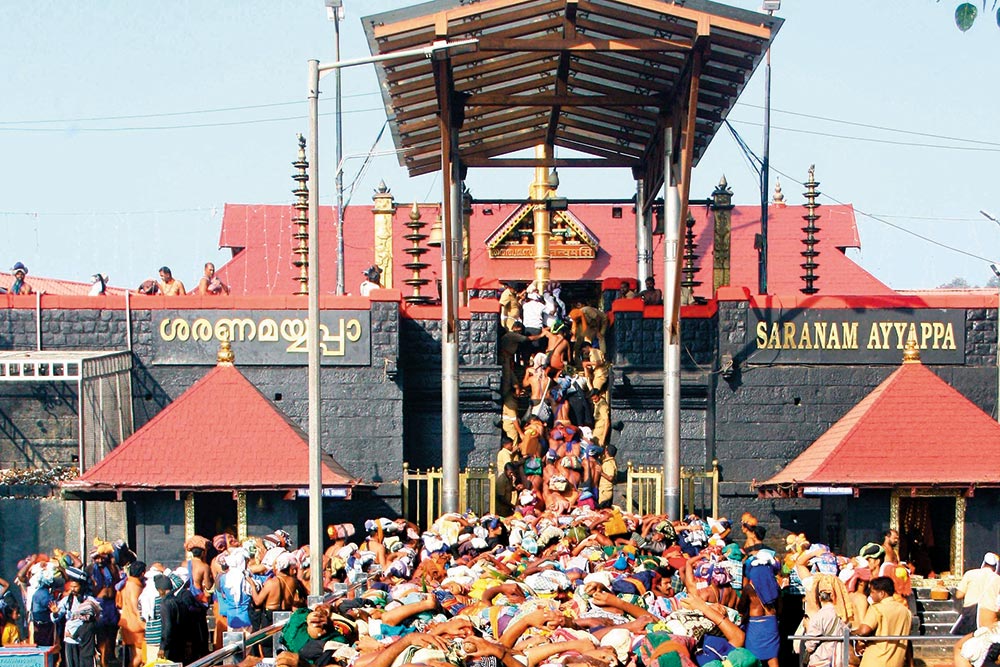Sabarimala pilgrimage is one of the rarest spiritual communions of all types of devotees from various parts of the world beyond race, religion, caste and class. The conspicuous absence of divisive politics in this part of the world ought to be celebrated by everyone, as the Lord Ayyappa is known for his utter celibacy and absolute penance in the dense forest of Periyar Tiger Reserve. The legacy and lineage of the erstwhile Pandiya Kingdom, Maharaja Sri Raja Sekara Pandiyan has been a philocrisy for the multitudes in India and overseas. The longest route called ‘Peru Vazhi’ stretches into a wild forest wherein you trek carefully by looking at the beauty of this tiger reserve and the elephant corridor by chanting the names of the Lord Ayyappa. The cosmic communion of the supreme forces of eternity could alter one’s destiny spontaneously when one seeks the spiritual solace through the incessant communion with the Lord Sabari Nathan during the austere penance through absolute purity. Many of the devotees stay etched in this ecstatic communion with the Bhagavan Ayyappa. Most of the rationalists might blink on such experiences, as they limit themselves with materialist analogy. Sometimes, it may be wise to open up one’s horizons of understanding through spiritual pursuits by practising meditation and pilgrimage. It is quintessential for spiritual enlightenment to remain disconnected with the world of materialistic pursuit while chanting the saranams (names of the Lord Ayyappa and his subordinate deities) and practise all the norms of the divine penance initiated several centuries ago in order to awaken the spirit of ecstatic oneness with the Holy Abode of the Lord Shri Dharma Sastha. Some of the conspicuous norms are all about eco-friendly life style with vegetarian food, purification of the body and mind every morning and evening, puja for the Lord Ayyappa, chanting saranams of the Lord Ayyappa and practising brahmachariyam/ celibacy, treating every being as the inseparable part of the Lord Ayyappa by calling them ‘Swamy’ (Gender neutral) and ‘Malikaipuram’ (for the women pilgrims and girl children). Swamy means– “the one who has conquered the self.” All the devotees of the Lord Ayyappa carry Irumudi kettu– a special divine offering of the coconut filled with ghee along with several other puja ingredients on their head while trekking the holy hills. Every devotee is supposed to greet one another by saying “Swamy Saranam” and “Saranam Ayyappa”. The state government of Kerala and Travancore Devaswom Board have transformed the hygiene of Sabarimala by creating several facilities for the millions visiting this Supreme Abode of the Lord Shri Dharma Sastha. Kudos to the Leadership of the Chief Minister Sri Pinarayi Vijayan! Most of the shops and small restaurants are quite supportive to the pilgrims, as the ground reality is a grand celebration of spiritual as well as social harmony and secular tradition of our motherland irrespective of caste, creed or religion. A large number of small outlets, temporary sheds, annadhana (free food offerings) along with herbal drinking water service of Ayyappa Seva Sangam (a charity), food vendors, free medical camps are the exemplary examples of how the Lord Sabari Giri Eswaran (another name of the Lord Ayyappa) inspires selfless service at the steepest mountains through His everlasting bliss. Anyone can get to know about the miracles and mysteries of the Lord Ayyappa by interacting with any ardent devotee or group of devotees at any point of time in any of these sheds in the wild forest while climbing up the holy hills of Pandala Raja. These authentic experiences of the devotees could be documented in order to preserve this noble spiritual tradition for the posterity. The Lord Ayyappa is also called Annadhana Prabu and most of the Guruswamies state the significance of giving free food for the other pilgrims as part of their penance (either through the Travancore Devaswom Board or Ayyappa Seva Sangam /any other appropriate method at the moment). The first destination is Erumeli – where you find Pettai Sastha and Erumeli Shri Dharmasastha temple besides the famous Mosque known as Vavaru Ambalam. This pilgrimage begins with the blessings of Pettai Sastha temple along with the dance (often called Pettai) and chanting of “Swamy Thinthaka thom!” and “Ayyappa Thinthaka thom!” Most of the kanni swamies (first timers or those who are in the first three years of their pilgrimage) are expected to carry Saram- (One of the smallest wooden arrows/ sticks) along with some offerings or prasadams such as banana while doing this ritual of Pettai. These pilgrims apply various colours on their faces and bodies while performing this ancient tribal ritual. It is believed that the Lord Sabari Giri Vasan performed these rituals en route to Sabraimala when His incarnation was actually to demonstrate how the evil forces are destroyed by the Divine Supremacy on the earth, Some of the Guruswamies (the Chief Spiritual Initiators of a group of pilgrims) believe that this ritual happens to exorcise the evil spirits from the possessed or empowers one with positive vibes (equivalent to ‘bhava spandana’) through group/mass communion. The group chanting of devotees of the Lord Ayyappa could be heard 24×7 in almost all the important destinations of the pilgrimage and especially near Pampa Ganapathy temple. Sabarimala is famously called after the tribal saintSabari- whose penance to meet the Lord Ram is always referred in our ancient epics and legends. The most revered tribal saint–Sabari’s spiritual legacy has also been worshipped and honoured at ‘Sabri Peetham’ for several hundreds of years. The kanni swamies ought to leave their sarams (the holy sticks/arrows) at ‘Saram Kuthy’ on their way from Pampa to Sannidhanam/the holy shrine. Thousands of devotees visit several shrines such as the Lord Krishna temple and Mammiyur Mahadeva Temple in Guruvayur, Sri Chootaranikara Bhagavathy temple,Kodankallur Bhagavathy temple, Ettumanoor Arthanarieswara temple, Triprayar Sri Ramaswamy temple, Lord Muruga temple in Palani, Madurai Meenakshi Amman Temple, Pazhamuthir Cholai Murugan Temple, Thiruparankundram Murugan temple,Kuttralanathar temple,Kulathupuzhai t e m p l e , A c h a n k o v i l temple,Ariyankavu temple, Vaikkam Mahadevan Temple, in the southern states en route to the Supreme Abode of the Lord Ayyappa.

















